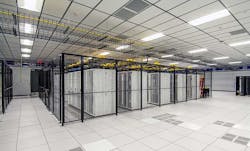ALLEN, Texas – The location of loading docks and staging rooms may seem like an esoteric element of data center design. Unless you’re rolling a rack filled with a ton of expensive server and storage equipment.
In that scenario, said Chris Crosby, the number of turns and ramps and the length of corridors matters a lot.
“We’re very intentional about equipment flow, and and how people use a building,” said Crosby, the CEO of Compass Datacenters. That’s why the loading dock is directly across from the server staging room, which is adjacent to a ramp providing direct access to the data hall.
As he walks the halls of a Tierpoint data center in the Dallas suburbs, Crosby says these details are the fruit of the Compass team’s years of experience building data centers for the world’s largest companies.
Crosby was a key player on the Digital Realty team that pioneered the wholesale data center, effectively creating a market for “plug and play” IT space. He founded Compass in 2012 to bring the wholesale product into regional markets, looking beyond major tech hubs like Silicon Valley.
Early Compass projects have been built in places like Nashville, Minneapolis, Durham and Tulsa. Its approach features smaller data centers, offering up to 2.4 megawatts of IT capacity. Each building is dedicated to a single customer, but offers a menu of options to address different requirements. This allows Compass to standardize its design, using pre-fabricated components to control cost and speed to market, while acknowledging that no two customers are alike.
This strategy, effectively a “white label” approach to wholesale data centers, has been embraced by service providers. Tierpoint, Windstream and CenturyLink are among the companies using Compass buildings, which enable them to quickly enter new markets.
A Partner to Scale With
Compass entered a new phase earlier this year, when private equity firm Redbird Capital and the Ontario Teachers Pension Fund bought a majority interest in the company, with Crosby and the Compass management team retaining an equity stake and continuing to head the company’s operations.
“It’s been really, really great having a good partner with deeper pockets,” said Crosby. “It allows us to execute at the scale we want. We have been able to do what we want from a land perspective, as well as reassure our customers that we can do what they need us to do.”
That includes pursuing bigger customers and competing in larger markets. Last year Compass updated its design to offer slightly larger facilities, with an eye toward working with cloud service providers, which tend to provision capacity in larger chunks. One of the more intriguing opportunities for Compass is the market for “availability zones” for cloud providers, offering redundancy and footprints in new markets as well as expansion capacity in some major markets.
Compass has also beefed up its executive team in recent months, adding two industry veterans in key posts. Jared Day joins as President and Chief Financial Officer, after serving in previous posts at cloud security provider Armor Defense. Senior Vice President of Construction Nancy Novak joins Compass from Balfour Beatty Construction.
Leading With Land Development
A tour of the Tierpoint data center in Allen provides a window into how Compass builds facilities for its clients. It’s a process that spans the full range of data center competencies, beginning with site selection and land acquisition. That process is led by Chris Curtis, Senior VP of Development and Acquisitions at Compass, whose experience includes more than 25 greenfield build-to-suit projects for government clients, including the FBI and Homeland Security. Curtis’ 2013 Data Center Development Diary at DCK provided an informative look inside the site selection, planning and development process..
“Our land development capabilities are unique, and that’s a big advantage for us,” said Crosby.
The TierPoint data center on a campus in Allen, Texas. The facility was built by Compass Datacenters. (Photo: Compass)
Compass pursues a campus strategy, enabling customers to easily expand in phases to add additional capacity as demand dictates. Tierpoint is the anchor tenant on the 12-acre Allen campus, with one data center completed and room for two additional phases, which will be connected via a central personnel corridor.
Compass describes its designs as “Your Data Center, Your Way.” Tenants can choose from a menu of options to personalize each facility, with choices on the site, building, data hall, mechanical/electrical infrastructure, security and the building management system.
In Allen, the campus has a security fence, and dual manholes for fiber entry, along with a mesh cabling topology that allows users to isolate failures in smaller failure zones.
Inside one of the color-coded power rooms inside the TierPoint data center in Allen, Texas. (Photo; Rich Miller)
To speed construction, the entire building is precast, allowing Compass to go from foundation to a completed building framework in 18 to 21 days, including the roof. The TierPoint data center in Allen went from dirt to delivery in less than six months.
The color schemes and internal branding are all controlled by the client, who can also choose the security system. The break room and employee conference rooms can be personalized as well. “This is really where they make the data center theirs,” said Crosby.
Color-Coded Mistake Proofing
The power distribution infrastructure embraces the Japanese principle of “poka-yoke” (mistake proofing in lean manufacturing) by color-coding the power paths for the redundant systems, including cabling and the power rooms. Each power room is pre-fabricated and then attached to the building, and includes two 2-megawatt generator engines. There’s a blue room and orange room to tie into the power chain color scheme.
One of the recent additions to the Compass design is the cooling infrastructure, which now employs the Kyoto Cooling heat wheel (also known as a rotary heat exchanger) attached to the rear of the building. The Kyoto Cooling heat wheel eliminates the need for chillers in most operating conditions, but offers advantages over direct fresh air cooling, eliminating risk from contamination and humidity. The two airflows never meet or mix.
As the wheel spins between two compartments, the ambient air cools the wheel, and then the wheel cools the supply air, which enters the data center through a cooling plenum along the back of the building. Compass uses four 400kW 4 kyoto units for each 1.2 MW hall, with one spare. The Kyoto units also improve the energy efficiency of the building, a key consideration for cloud-scale players.
A fan wall inside the cooling plenum in a Compass Datacenters facility in Allen, Texas. The fans are fed by cool air from a Kyoto Cooling unit. (Image: Compass Datacenters)
All this power and cooling infrastructure supports a 16,000 square foot raised floor data hall, featuring a three-foot raised floor and an overhead plenum for return air. An integrated ceiling grid provides support for overhead cable trays and rack-level power distribution. Slab design available for hyperscale customers.
More Land in the Pipeline
Compass has recently broken ground on a second parcel adjacent to the Tierpoint facility, where it will build a data center for an enterprise customer.
“There’s a big local play, not just enterprises, but also regional footprints,” said Crosby. “From a network perspective, more workloads need to stay local. Hopefully, we can continue to provide a compelling value.”
Compass will soon have competition in Allen, a suburb about 30 miles north of Downtown Dallas, as CyrusOne has purchased 65 acres of nearby land where it plans to build 1.4 million square feet of space. Crosby says the new neighbors simply reinforce Compass’ site selection expertise and value proposition.
If Compass has been intentional about the details of its data centers, it has also been intentional about where to build. After five years of success in second-tier cities, Compass is moving into larger markets and targeting hyperscale customers, who may appreciate its speed to market and tenant-friendly designs. In addition to its presence in the Dallas market, Compass also has purchased land for a campus near Atlanta, and is in the early planning process for a property in Northern Virginia, the world’s largest data center market.
“We started out trying to stay away from competition,” said Crosby. “We did that, with very successful outcomes. Now our business has been vetted well enough to be relevant in markets like Dallas and Northern Virginia.”






